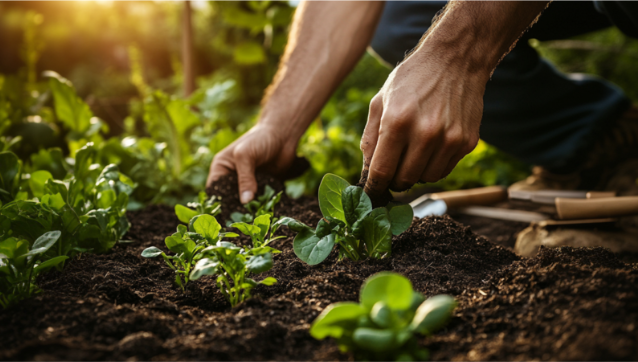As summer reaches its peak, many gardeners worry that they’ve missed the boat. Maybe your summer crops didn’t turn out as expected, or perhaps you’re wondering how to make the most of those empty spaces. Don’t worry—there’s still time to make this growing season count! Late-summer planting can feel like a race against the clock, but with the right strategy, it’s your golden ticket to a flourishing fall harvest.
A gardener preparing a garden bed in late summer, adding compost and mulch to the soil under a warm sunset. Fresh seedlings of spinach and lettuce ready to be planted, garden tools nearby. Lush greenery surrounding the bed.
Understanding Your Growing Season
The first step to a productive fall garden is understanding the growing season. Identify the average first frost date in your region. This helps determine the best time frame for planting. Most fall crops need about 45 to 60 days to mature, so you’ll need to plan accordingly. You can also consult your local agricultural extension service for specific information on frost dates and growing seasons in your area. USDA’s Plant Hardiness Zone Map is a great resource for this.
Choosing the Right Crops for Late-Summer Planting
Certain vegetables thrive in the cooler temperatures of fall. Below are some of the top candidates for late-summer planting:
- Leafy Greens: Spinach, lettuce, kale, and Swiss chard grow quickly and tolerate light frosts.
- Root Vegetables: Carrots, beets, and radishes develop their best flavor in cooler weather.
- Brassicas: Broccoli, cauliflower, and Brussels sprouts prefer autumn’s cooler temperatures and can survive light frosts.
- Legumes: Bush beans can still be planted for a late harvest, but they must mature before the first frost.
- Herbs: Cilantro, parsley, and dill thrive in cooler weather and can be harvested well into the fall.
Want to ensure your garden’s success? Follow us and learn how to prepare your garden beds and plant at the perfect time!
Preparing Your Garden for Late-Summer Planting
Preparing your garden beds is essential before planting new crops. First, clear any remaining summer crops and weeds to reduce competition for nutrients and water. Next, add compost or aged manure to enrich the soil and ensure it has the necessary nutrients to support new growth. Finally, mulch the beds to retain moisture and regulate soil temperature.
Planting Tips for Late-Summer Success
Timing is everything when it comes to a successful fall garden. Here are some helpful tips to achieve the best results:
Succession Planting
Stagger your plantings every two weeks to extend the harvest period and ensure a continuous supply of fresh produce. This technique maximizes your garden’s productivity and helps avoid overwhelming harvests.
Transplants vs. Seeds
For some crops, using transplants can give you a head start. For example, broccoli and cauliflower can be started indoors and then transplanted outdoors. Choosing between transplants and seeds depends on the growing season and the crop’s specific needs.
Watering
Consistent watering is important, especially in the late summer heat. Make sure the soil remains moist but not waterlogged. Use soaker hoses or drip irrigation systems to deliver water directly to the roots.
Fertilizing
Apply a balanced fertilizer to support the rapid growth of fall crops. Always follow the manufacturer’s recommendations for the amount and frequency of application. For more tips on soil health, visit The Old Farmer’s Almanac.
Protecting Against Frost
As fall approaches and temperatures begin to drop, it’s essential to protect your crops from frost. Failing to protect your plants from frost can lead to wilting, damage to leaves, and even the death of sensitive crops, drastically reducing your harvest. Below are some effective strategies:
Row Covers
Lightweight row covers protect plants from frost while allowing sunlight and water to penetrate. You can leave row covers all day and night.
Cold Frames
Cold frames provide a more substantial barrier against frost. They can extend the growing season by several weeks, allowing plants to thrive in cooler temperatures.
Mulching
A thick layer of mulch helps insulate the soil and protect root vegetables from freezing temperatures. For additional frost protection tips, check out Gardener’s Supply Company.
Harvesting Your Fall Crops
Proper harvesting techniques are crucial to getting the most from your fall crops. Below are some important tips:
Timing
Harvest crops at their peak to get the best flavors and nutritional values. Leafy greens should be picked when they are young and tender. Meanwhile, root vegetables can remain in the ground until just before a hard frost.
Storage
Many fall crops store well. Root vegetables, for instance, can be kept in a cool, dark place for several months, often up to six months depending on the variety. Leafy greens can be blanched and frozen for later use, typically lasting up to 8 to 12 months in the freezer.
Bring Your Garden Full Circle This Fall
Planting a fall garden isn’t just about squeezing out a few more veggies before winter. On the contrary, it’s about maximizing your garden’s potential and enjoying fresh produce long after the summer sun has faded. You can ensure a bountiful harvest by understanding your growing season, choosing the right crops, and following best practices for planting and frost protection.
PS: We’re excited to see how your late-summer planting journey unfolds! Share your stories, photos, and tips with us—let’s grow together and celebrate the season’s successes! For more gardening tips and ideas, check out our complete guide to fall gardening.



